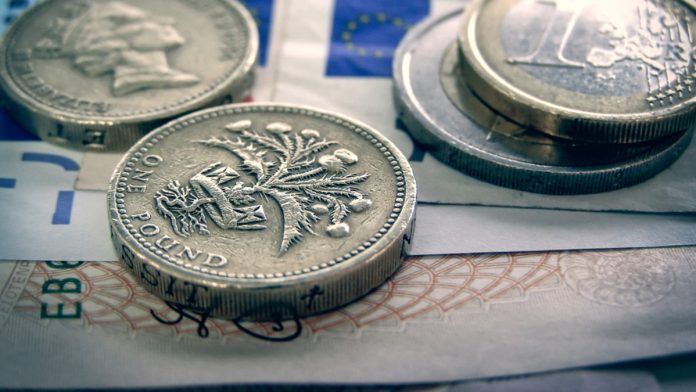The pound pared early gains versus the euro on Monday. After surging to a peak of €1.1686, the pound euro exchange rate fell across Monday afternoon and overnight to a low of €1.1609.
| What do these figures mean? |
|---|
| When measuring the value of a pair of currencies, one set equals 1 unit and the other shows the current equivalent. As the market moves, the amount will vary from minute to minute. If the euro amount increases in this pairing, it’s positive for the pound. Or, if you were looking at it the other way around:1 EUR = 0.87271 GBPIn this example, €1 is equivalent to approximately £0.87. This measures the euro’s worth versus the British pound. If the sterling number gets larger, it’s good news for the euro. |
The pound bounded out of the starting blocks on Monday, boosted by hopes of UK Prime Minister Theresa May pushing her Brexit deal through Parliament. Theresa May was originally looking at another defeat in meaningful vote which will be held on 12th March. However, the Eurosceptics are slowly coming around to her deal, in fear of Brexit not happening at all. Theresa May is also bribing the opposition, with promises of cash for poorer areas in return for votes. Should Theresa May push her deal through the UK will have a soft, organized Brexit, which economists believe is infinitely better for the pound than a hard, chaotic Brexit.
| Why is a “soft” Brexit better for sterling than a “hard” Brexit? |
|---|
| A soft Brexit implies anything less than UK’s complete withdrawal from the EU. For example, it could mean the UK retains some form of membership to the European Union single market in exchange for some free movement of people, i.e. immigration. This is considered more positive than a “hard” Brexit, which is a full severance from the EU. The reason “soft” is considered more pound-friendly is because the economic impact would be lower. If there is less negative impact on the economy, foreign investors will continue to invest in the UK. As investment requires local currency, this increased demand for the pound then boosts its value. |
The pound lost ground as UK construction sector data disappointed market participants. The construction pmi fell to 49.5 in February, whereby 50 separates contraction from expansion. This is the lowest reading since March 2017. The slowdown in the sector comes as Brexit uncertainty hits confidence and as builders struggle to get hold of the materials they need amid a sharp increase in stockpiling. The weak data pulled the pound off its earlier highs.
Today the UK service sector figures will be under the spotlight. The UK service sector makes up around 80% of economic activity in Britain. It is an extremely important sector. In January activity in the service sector just managed to remain in expansionary territory at 50.1. Today investors will be looking to see whether this remains the case. A weak reading could suggest that the UK economy is heading for a contraction in the first quarter of this year.
Further Contraction For Italy’s Economy?
The euro edged lower in the previous session. There were no high impacting data releases from the eurozone and the US was also relatively quiet. This is relevant because the euro often trades inversely to the dollar. However, the euro still moved lower as investors look ahead to Thursday’s European Central Bank monetary policy announcement. Rumours are circulating that the ECB could look to loosen policy moving further away from a rate rise.
| Why do raised interest rates boost a currency’s value? |
|---|
| Interest rates are key to understanding exchange rate movements. Those who have large sums of money to invest want the highest return on their investments. Higher interest rate environments tend to offer higher yields. So, if the interest rate or at least the interest rate expectation of a country is relatively higher compared to another, then it attracts more foreign capital investment. Large corporations and investors need local currency to invest. More local currency used then boosts the demand of that currency, pushing the value higher. |
Today investors will have more data to focus on. Releases include eurozone retail sales and service sector data for the bloc. Another key release will be the Italian GDP. Analysts are expecting this to show the Italian economy contracted in the fourth quarter. Concerns over the health of the Italian economy, the third largest economy in Europe could pull the euro lower.
This publication is provided for general information purposes only and is not intended to cover every aspect of the topics with which it deals. It is not intended to amount to advice on which you should rely. You must obtain professional or specialist advice before taking, or refraining from, any action on the basis of the content in this publication. The information in this publication does not constitute legal, tax or other professional advice from TransferWise Inc., Currency Live or its affiliates. Prior results do not guarantee a similar outcome. We make no representations, warranties or guarantees, whether express or implied, that the content in the publication is accurate, complete or up to date. Consult our risk warning page for more details.
This article was initially published on TransferWise.com from the same author. The content at Currency Live is the sole opinion of the authors and in no way reflects the views of TransferWise Inc.





